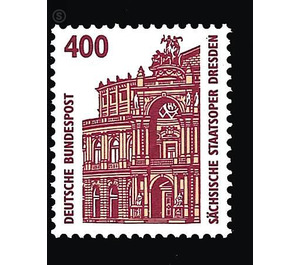Postage stamps: sights - Germany / Federal Republic of Germany 1991 - 400 Pfennig
Theme: Art & Culture
| Country | Germany / Federal Republic of Germany |
| Issue Date | 1991 |
| Face Value | 400.00 |
| Color | brown white |
| Perforation | K 14 |
| Printing Type | indirect 2-color letterpress |
| Stamp Type | Postage stamp |
| Item Type | Stamp |
| Chronological Issue Number | 1435 |
| Chronological Chapter | GER-BRD |
| SID | 770492 |
| In 48 Wishlists | |
Gottfried Semper designed his second Dresden opera house in the style of the late Italian Renaissance, where he organically linked their ornamental forms with the built. In this sense, his new court theater was a consummate artistic entity, unparalleled. For sixty-seven years, this building was in the center of dramatic art, in particular filled with the sound of the Dresden Staatskapelle and the names of prominent conductors and soloists, until it fell victim to the bombing raid in February 1945, together with the city and the other Dresden buildings of Semper. He owes his worldwide reputation to the artistic achievements of the house as well as to the impressive festivity of his architectural design and was at the same time a document of Gottfried Semper's merit of rearranging German theater building in terms of content and form. At him revealed his artistic credo that the function of a building in plan, exterior and jewelry must find their expression. The reconstruction of a theater that is of historical importance, but in its functional structure corresponds to the claims for use of the 19th century, is always subject to a decision-making compulsion that leads to the question of historical or modern. With the destruction of the house, the entire auditorium and the stage house were destroyed; only the load-bearing walls and the foyers and vestibules were preserved, albeit severely affected. If the Semperbau - except the necessary supplement with side stages - externally returned to its original version, it should also give a meaningful correspondence inside, so that no break between external and internal attitude. This was only possible if the structural and formal structure of the former auditorium repeated itself. In its design, the auditorium of the third Semperoper largely uses that of the old. Despite the complete destruction, it was possible to reproduce his festive character on the basis of the archive material of the Dresden Institute for the Preservation of Historical Monuments in painstaking detail work on the drawing board and in the execution. The restoration of pictorial design, which was important for the artistic coherence of semper's work and encompassed the entire painterly and sculptural decoration of the interior and exterior, with which the purpose of the house was counterbalanced in pictorial art, made special demands on the preparation and execution. Almost all pictures and sculptures of the interior were lost. They had to be recreated with the help of a few photographs and replicas left behind. For the eighty-two sculptors and painters who had to take over this artistically unusual work under art-scientific guidance, this required great stylistic empathy. The artistic production in the theater is directly dependent on the technical. These institutions, more or less hidden from the general public, are an important prerequisite of any theater without which there would be no ideas. Through the formation of a cross stage, the house has been equipped with the most modern aspects of stage technology. It is necessary to maximize the time required for scenic transformations when using as few technical workers as possible. Furthermore, a turntable corresponding to the size of the stage was stationed on the rear stage, which can be driven to the main playing surface if necessary. According to the same principle can be used in the side stage area stage wagon, which serve a quick change of decoration. The present work brought together building contractors, architects, art historians, monument conservationists and artists to an unprecedented degree. Just as the construction of this national cultural monument and monument is a document of the preservation and preservation of our architectural heritage, the reconstructed building should be the obligatory shell in which to continue its glorious tradition. (Text: Hanns Matz / Wolfgang Hänsch, Dresden)


